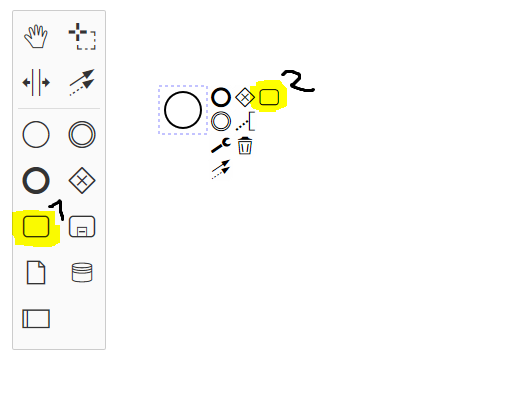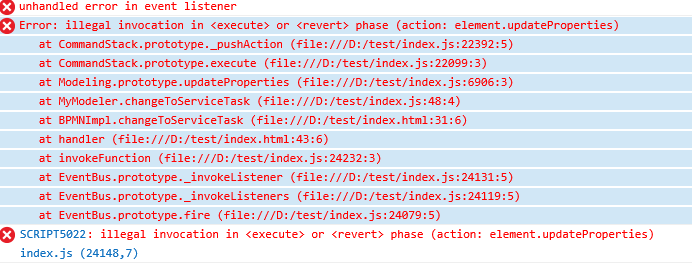Thanks for your response.

Instead of adding a normal “Task”, we want to add a “ServiceTask” by default.
I tried to change the type of the “Task” to a “ServiceTask” after adding the “Task” shape, what not worked.
But actually I found some examples to modify the editor, so may the better solution would be to modify the editor instead of change the element type after the shape was added!?
Unfortunately I can`t use git at this Moment, but I hope my codesnippets would help to understand.
If not, let me know and i will find a solution to share the full code.
My index.js was build with npm and grunt. I dont know If this is best practise, cause as you can see I need a wrapper object to call modeler methods in the index.html, but it works fine.
index.html
<!DOCTYPE HTML>
<html>
<head>
<meta http-equiv="X-UA-Compatible" content="IE=edge" />
<meta charset="UTF-8" />
<title>Test</title>
<link rel="stylesheet" href="css/diagram-js.css" />
<link rel="stylesheet" href="vendor/bpmn-font/css/bpmn-embedded.css" />
<link rel="stylesheet" href="css/app.css" />
</head>
<body onload="BPMNImpl.openDiagram('');">
<div id="js-drop-zone">
<div class="canvas" id="js-canvas" style="height: 500px;">
</div>
</div>
<script>
var BPMNImpl = {
mModeler : undefined,
setModeler : function( pModeler ) {
mModeler = pModeler;
},
openDiagram: function(xml) {
mModeler.openDiagram(xml);
},
registerEventHandler : function( pEvent, pFunction ) {
mModeler.registerEvent( pEvent, pFunction );
},
changeToServiceTask : function ( pElement ) {
mModeler.changeToServiceTask(pElement);
}
}
</script>
<script src="index.js"></script>
<script>
function handler(event, pElement) {
console.log("Handler called.");
if (pElement.element !== undefined && pElement.element.type === "bpmn:Task" ) {
// Here we become an error.
BPMNImpl.changeToServiceTask(pElement);
}
}
function handler2( event, pElement ) {
console.log("Handler2 called.");
if (pElement.element !== undefined && pElement.element.type === "bpmn:Task" ) {
// This works! But I need to click out of the element and then click the element again
// it does not change direct.
//BPMNImpl.changeToServiceTask(pElement);
}
}
BPMNImpl.registerEventHandler( "element.click", handler );
BPMNImpl.registerEventHandler( "shape.added", handler );
BPMNImpl.registerEventHandler( "element.changed", handler2 );
</script>
</body>
</html>
index.js - snipped of the my “compiled” version with grunt. at the end your code follows and is not displayed…
based on bpmn-js 1.0.1
(function(){function e(t,n,r){function s(o,u){if(!n[o]){if(!t[o]){var a=typeof require=="function"&&require;if(!u&&a)return a(o,!0);if(i)return i(o,!0);var f=new Error("Cannot find module '"+o+"'");throw f.code="MODULE_NOT_FOUND",f}var l=n[o]={exports:{}};t[o][0].call(l.exports,function(e){var n=t[o][1][e];return s(n?n:e)},l,l.exports,e,t,n,r)}return n[o].exports}var i=typeof require=="function"&&require;for(var o=0;o<r.length;o++)s(r[o]);return s}return e})()({1:[function(require,module,exports){
'use strict';
var MyModeler = {
initialDiagram : '<?xml version="1.0" encoding="UTF-8"?>' +
'<bpmn:definitions xmlns:bpmn="http://www.omg.org/spec/BPMN/20100524/MODEL" ' +
'xmlns:bpmndi="http://www.omg.org/spec/BPMN/20100524/DI" ' +
'xmlns:di="http://www.omg.org/spec/DD/20100524/DI" ' +
'xmlns:dc="http://www.omg.org/spec/DD/20100524/DC" ' +
'xmlns:camunda="http://camunda.org/schema/1.0/bpmn" ' +
'xmlns:xsi="http://www.w3.org/2001/XMLSchema-instance" ' +
'id="Definitions_1" ' +
'targetNamespace="http://bpmn.io/schema/bpmn" >' +
'<bpmn:process id="Process_1" isExecutable="true">' +
'<bpmn:startEvent id="StartEvent_1"/>' +
'</bpmn:process>' +
'<bpmndi:BPMNDiagram id="BPMNDiagram_1">' +
'<bpmndi:BPMNPlane id="BPMNPlane_1" bpmnElement="Process_1">' +
'<bpmndi:BPMNShape id="_BPMNShape_StartEvent_2" bpmnElement="StartEvent_1">' +
'<dc:Bounds height="36.0" width="36.0" x="173.0" y="102.0"/>' +
'</bpmndi:BPMNShape>' +
'</bpmndi:BPMNPlane>' +
'</bpmndi:BPMNDiagram>' +
'</bpmn:definitions>',
openDiagram : function( pXML ) {
console.log("Open Diagram: " + pXML);
if ( pXML === undefined || pXML === "" ) {
pXML = MyModeler.initialDiagram;
}
modeler.importXML( pXML, function( err ) {
if ( err ) {
$( '#js-drop-zone' ).removeClass( 'with-diagram' ).addClass( 'with-error' );
$( '#js-drop-zone' ).find('.error pre').text( err.message );
console.error( err );
} else {
console.log("Diagram loaded");
$('#js-drop-zone').removeClass( 'with-error' ).addClass( 'with-diagram' );
}
});
},
changeToServiceTask : function( pElement ) {
pElement.element.type = "bpmn:ServiceTask";
var elementRegistry = modeler.get( 'elementRegistry' );
var elementRegistryEntry = elementRegistry.get( pElement.element.id );
modeler.get( 'modeling' ).updateProperties( elementRegistryEntry, { type: "bpmn:ServiceTask" } );
},
registerEvent : function( event, handler ) {
var eventBus = modeler.get( 'eventBus' );
eventBus.on( event, handler );
}
};
var $ = require( 'jquery' ),
BpmnModeler = require( 'bpmn-js/lib/Modeler' );
try {
BPMNImpl.setModeler( MyModeler );
}
catch ( err ) {
console.error( "Error setting Modeler: " + err );
}
var modeler = new BpmnModeler( {
container: $( '#js-canvas' ),
moddleExtensions: {
camunda: require('camunda-bpmn-moddle/resources/camunda')
}
} );
},{"bpmn-js/lib/Modeler":2,"camunda-bpmn-moddle/resources/camunda":114,"jquery":295}],2:[function
....
This is the error, I get If I drop/add a “Task” to the diagram.



